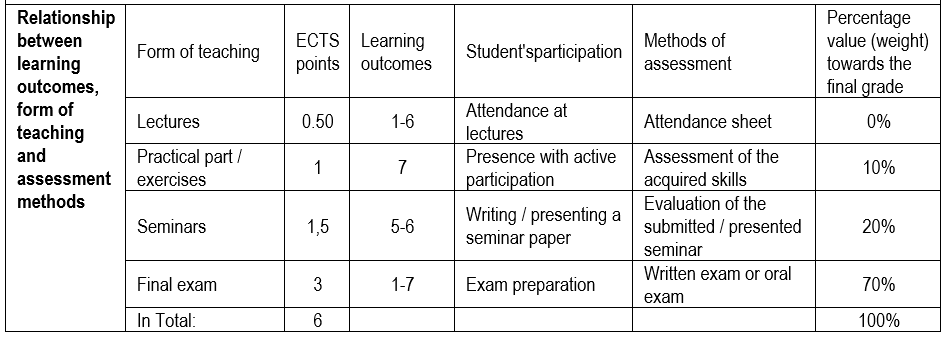Students will learn the basics of biological processes and their regulation at the molecular level. The objective of the course is to transfer knowledge from basic biochemical processes that enable living organisms to function normally, maintain optimal concentration of ingredients in cells and bodily fluids, and processes involved in growth and reproduction.
The course Anatomy will be observed from a functional viewpoint with special emphasis on clinical anatomy of adults. In clinically significant fields students have to know the anatomy of children, youth and pregnant women. Students have to be qualified to find and identify anatomaGeneral introduction. An explanation of the general importance of biochemistry and treatment of diseases. General information on the intermediate metabolism. General information on the regulation of metabolic pathways. Oxidation processes in a cell related to energy generation. Carbohydrates. Digestion of carbohydrates. Degradation and biosynthesis of carbohydrates. The regulation of carbohydrate metabolism. Diseases associated with carbohydrate metabolism defects. Lipids. Lipid digestion. Cellular degradation and biosynthesis of simple and complex lipids. Metabolism of cholesterol and bile acids. Lipoprotein metabolism. Metabolism of eicosanoids. Regulation of lipid metabolism. Diseases associated with lipid metabolism defects. Amino acids. Protein digestion. Intracellular protein breakdown. Amino acid degradation. Biosynthesis of non-essential amino acids. Regulation of of amino acid metabolism speed. Diseases associated with amino acids metabolism defects. Amino acids as a source of substances in biosynthesis. Biosynthesis and nucleotide degradation. Regulation of nucleotide metabolism. Diseases associated with nucleotide metabolism defects. Nucleic acids. Structure and characteristics of DNA. DNA replication and reparation. The RNA biosynthesis. Post-transcription modifications. Regulation of RNA biosynthesis. Degradation of nucleic acids. Genetic code. Genetic diseases. Proteins. Biosynthesis of proteins. Post-translation modifications. Regulation of the of protein biosynthesis rate. Biosynthesis of individual (selected) proteins. Basics of genetic engineering. Recombinant DNA technology. The use of recombinant DNA technology in dental medicine. Hormones. Hormone biosynthesis. Hormone excretion. Hormone degradation. Mechanisms of hormone action. Cell signaling. The role of hormones in the regulation of metabolic processes. The role of hormones in homeostasis. Oral cavity biochemistry. The composition, characteristics and role of the saliva. The composition of hard dental tissues. Biomineralization process Molecular biology of hard dental tissue. The origin and importance of pellicles. Metabolic activity of oral bacteria. Biochemical aspects of dental caries. Protection from dental caries. The composition and characteristics of periodontium tissues. Biochemical processes in periodontium tissues.ic structures on the thorax, abdomen and extremities they will encounter in their clinical work every day. Furthermore, they have to recognise clinically significant differences that could affect the determination of clinical diagnoses and treatment. They have to recognise the mechanics of joint movement on the extremities and understand their significance during a clinical check-up.
Required course materials:
- Harperova ilustrirana biokemija; 28. izdanje, Medicinska naklada 2011.
- Glavaš-Obrovac Lj. i sur.; Interni priručnik za seminare i vježbe iz Medicinske kemije i biokemije 2, Medicinski fakultet Osijek, 2010.
- P. Karlson: BIOKEMIJA ZA STUDENTE KEMIJE I MEDICINE, Školska knjiga, Zagreb, 1993.
- L. Stryer: Biokemija, 2th izdanje, Školska knjiga, 1991.
- Radni materijali s predavanja
Upon completion of this course, students will be able to:
- Define biosynthetic reactions of the most important biochemical compounds and associate their structure with chemical reactions and metabolic changes;
- Discriminate principles of the biochemical and energetic changes as well as to compare regulatory mechanisms in the metabolism of carbohydrates, lipids, proteins, information macromolecules and signal molecules;
- Critically analyze metabolic changes at the level of single cell, tissues and the whole organism;
- Compare structure and function of biological membranes and extracellular matrix;
- Define progress and association of metabolic reactions in different tissues, discriminate signal molecules involved in cell signaling as well as to identify biochemical basis of certain metabolic diseases;
- Exam biochemical background of disorders caused by the structure of molecules as well as by biochemical reaction and processes;
- Define practical skills essential for work in the biochemical laboratory (basic of safety, basic calculation of biochemical parameters and understanding and interpretation of laboratory measuring).



